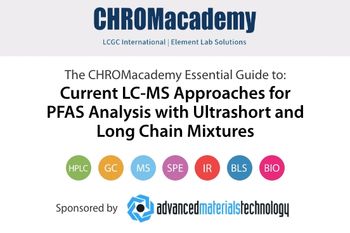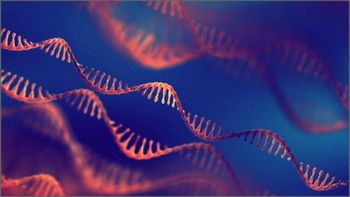
- LCGC North America-03-01-2016
- Volume 34
- Issue 3
Improved Sensitivity and Specificity for Trans-Resveratrol in Red Wine Analysis with HPLC–UV and LC–MS
Adequate detection of trans-resveratrol in wine is complicated by two factors: relatively low levels and interferences from matrix components. Here, we present two useful approaches to overcoming these issues depending on the instrumentation available. For HPLC–UV analyses, matrix peaks can be removed by microextraction using packed sorbent while simultaneously concentrating the trans-resveratrol peak by a factor of two. For LC–MS, the extracted ion chromatogram for the [M + H]+ analyte ion can be used to obtain specificity without prior extraction procedures.
Adequate detection of trans-resveratrol in wine is complicated by two factors: relatively low levels and interferences from matrix components. Here, we present two useful approaches to overcoming these issues depending on the instrumentation available. For high performance liquid chromatography (HPLC) analyses with ultraviolet (UV) detection, matrix peaks can be removed by microextraction using a packed sorbent while simultaneously concentrating the trans-resveratrol peak by a factor of two. For liquid chromatography-mass spectrometry (LC–MS), the extracted ion chromatogram for the [M + H]+ analyte ion can be used to obtain specificity without prior extraction procedures.
Resveratrol is a naturally occurring stilbenoid compound found in certain plant components, such as grape skins, peanuts, and berries. Although the practical extent of its therapeutic effects is debated, resveratrol has been variously reported to exhibit cardio-protective (1), anticancer (2), and neuroprotective (3) properties. A common point of contention with findings regarding the purported health benefits of resveratrol is that many such studies are performed in vitro or with animal subjects (4). Hence, the conclusions may not necessarily translate to in vivo human clinical trials, which are still relatively scarce at present (5). For example, the low bioavailability of resveratrol may not allow for the relatively high concentrations used to achieve significant efficacy in some in vitro studies (6).
Nevertheless, the amount of resveratrol in food and beverage products is of ongoing interest to producers and consumers. Red wine, a common food source of resveratrol, is therefore pertinent to analytical study in furtherance to these investigations. The content of resveratrol can vary widely among red wine samples depending on factors such as region of cultivation and grape variety, but reported values have ranged up to 14.3 mg/L (7). With ultraviolet (UV) detection in high performance liquid chromatography (HPLC) analyses, the lower levels found in some samples may be somewhat difficult to adequately quantitate. Furthermore, peaks from other components in the wine extracts may interfere with resveratrol detection. Liquid chromatography coupled to mass spectrometry (LC–MS) has been shown to be a powerful tool capable of detecting trans-resveratrol down to 0.3 pmol (8) and can also differentiate based on the mass-to-charge ratio (m/z), but many laboratories may lack this more sophisticated instrumentation. For analyses with UV-based instruments, a sample cleanup strategy is generally required before HPLC analysis.
In recent years, miniaturized solid-phase extraction (SPE) techniques have become an advantageous alternative to traditional sample cleanup or preconcentration procedures (9). Using conventional liquid-liquid extraction (LLE), relatively large amounts of solvent are typically required for a single sample, which increases cost for both solvent usage and disposal. The process is also not amenable to automation, taking up valuable analyst time. SPE greatly reduces solvent consumption compared to LLE, but can be attenuated further with more modern microextraction techniques. In addition to solvent savings, miniaturized SPE approaches require very low amounts of sample (on the order of microliters versus milliliters for SPE), which can be beneficial if the sample is expensive or scarce.
Microextraction by packed sorbent can be thought of as a type of miniaturized SPE technique where the solid phase is a small packed bed (~1–2 mg) incorporated into the barrel of a pipet needle. Carryover from previous samples using the same cartridge can be reduced or eliminated compared to traditional SPE because of the smaller sorbent bed and lower wash volumes involved (10). The process is also generally faster and more readily automated than SPE or LLE, since the packed sorbent bed is part of the syringe (11).
The extraction technique entails the same general principles as chromatography, with a few notable caveats. Because the process must be quantitative to be of use, extremes in retention or elution behavior are preferable. A sample is loaded onto the cartridge under strongly retaining conditions such that the analyte of interest will be quantitatively adsorbed onto the sorbent. Strongly eluting conditions are used to then completely remove the analyte from the packed bed and into the sample vial for analysis. Since the sorbent is smaller in microextraction by packed sorbent than in traditional SPE, greater attention must be paid to ensure the analyte loading capacity of the packed bed is not exceeded.
There are two primary reasons to incorporate a microextraction by packed sorbent procedure into sample preparation. First, compounds that are not retained on the sorbent are removed from the final sample, which might otherwise show up as interfering peaks in the subsequent HPLC chromatograms. Hence, the technique can improve the specificity of the analysis. Second, if the volume of liquid used in the elution step is lower than that of the loading step, an increase in analyte concentration is obtained. This can be performed by using one large volume in the loading step or through a series of extract–discard cycles of equal volume to the elution step. If an analyte is generally found in low levels in a particular sample, this microextraction by packed sorbent preconcentration technique may be an effective strategy to adequately detect and quantitate it. The resulting concentration increase is then accounted for in the analytical calculations, allowing for the quantitation of analytes present at levels below the linear range of the calibration curve.
In the present work, microextraction by packed sorbent approaches were investigated as a means to increase the concentration of resveratrol in red wine samples while simultaneously removing undesirable compounds from the extracts. A silica hydride–based C18 material was used as the sorbent in the cartridges and compared to an analogous C18 phase based on conventional silica. To our knowledge, this is the first instance of silica hydride sorbents used for a microextraction sample preconcentration application. Previous work on the utility of these materials as analytical HPLC columns in food and beverage analyses has been demonstrated for limonin in orange juice (12) and histamine in foodstuffs (13). Silica hydride–based sorbents have also been used in traditional SPE in an application analyzing components of dark chocolate (14).
One notable study (15) reported the use of microextraction by packed sorbent in analysis of trans-resveratrol in wine samples, but in that case a preconcentration factor of the extract was not used in the final method. Preconcentration had been investigated through the use of multiple extract–discard cycles of sample aliquots on the cartridges, and increases in peak areas were observed, but the results were not quantitative (for example, the use of five extraction cycles in the microextraction by packed sorbent preconcentration step in sample preparation yielded significantly less than a fivefold increase in peak area in the HPLC data, relative to that of the single extraction cycle). If the increase in concentration is to be accurately accounted for in the calculations, the peak area must be directly proportional to the preconcentration factor. Hence, another aspect of this study was to investigate the preconcentration aspect of the microextraction by packed sorbent technique more thoroughly.
Because of the inherent sensitivity and specificity capabilities of LC–MS, its use was investigated for analysis of trans-resveratrol in red wine as an alternative strategy to the microextraction by packed sorbent approach. This may be pertinent to researchers investigating resveratrol at very low levels or in more complex samples such as plasma extracts. Analysts can isolate the extracted ion chromatogram (EIC) corresponding to the [M + H]+ ion for resveratrol, leading to superior specificity compared to UV-based analyses. As such, extraction-based sample cleanup procedures may be unnecessary with the use of this more sophisticated instrumentation.
Materials and Methods
Articles in this issue
almost 10 years ago
BioChromatography with Reversed-Phase and HILIC Techniquesalmost 10 years ago
Column Plate Number and System Suitabilityalmost 10 years ago
Trends in Sample Preparationalmost 10 years ago
Flow or Velocity?almost 10 years ago
Vol 34 No 3 LCGC North America March 2016 Regular Issue PDFNewsletter
Join the global community of analytical scientists who trust LCGC for insights on the latest techniques, trends, and expert solutions in chromatography.





